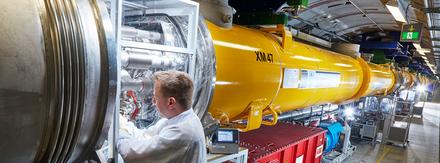Accelerator
The linear accelerator of the European XFEL is unique in the world. As the longest superconducting linear accelerator in the world, it provides the energy needed to generate the European XFEL's X-ray flashes. As an international effort involving 17 institutes, development of this critical portion of the facility is an example of excellent scientific cooperation across borders.

How it works
As an X-ray free-electron laser, the European XFEL requires energized free—that is, not bound to atoms—electrons to generate laser-like pulses of light in the X-ray wavelength range. Scientists can energize electrons by accelerating them—making them move in one direction at a speed ever approaching, but never quite reaching, the speed of light.
Scientists accelerate particles using a metallic structure called a cavity, also called a resonator. When an intense electromagnetic field is applied across a cavity, a particle carrying an electric charge, such as an electron, is moved through the structure. This happens at an increasing pace the more cavities are used.
The European XFEL accelerator currently uses 768 cavities over a 1.7 km length. Additionally, the facility uses the elemental metal niobium as the material for the cavities. Niobium is superconducting at extremely low temperatures, so when the cavities are chilled to -271°C—just 2°C away from the lowest possible temperature, absolute zero—they lose all of their electrical resistance. This means that any amount of electromagnetic signal that enters the cavity also goes directly into the electrons, making the acceleration process very efficient. The European XFEL accelerator can currently energize electrons up to 17.5 gigaelectronvolts (GeV).
